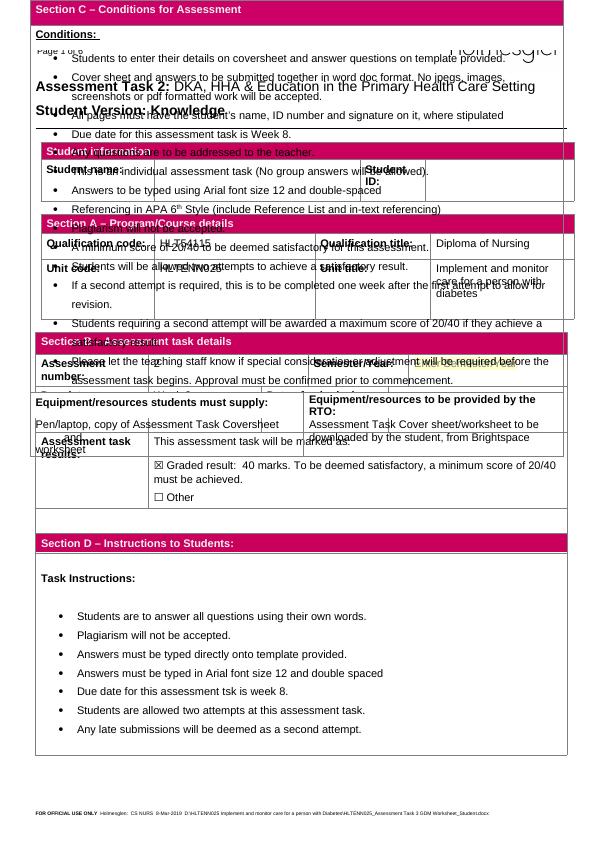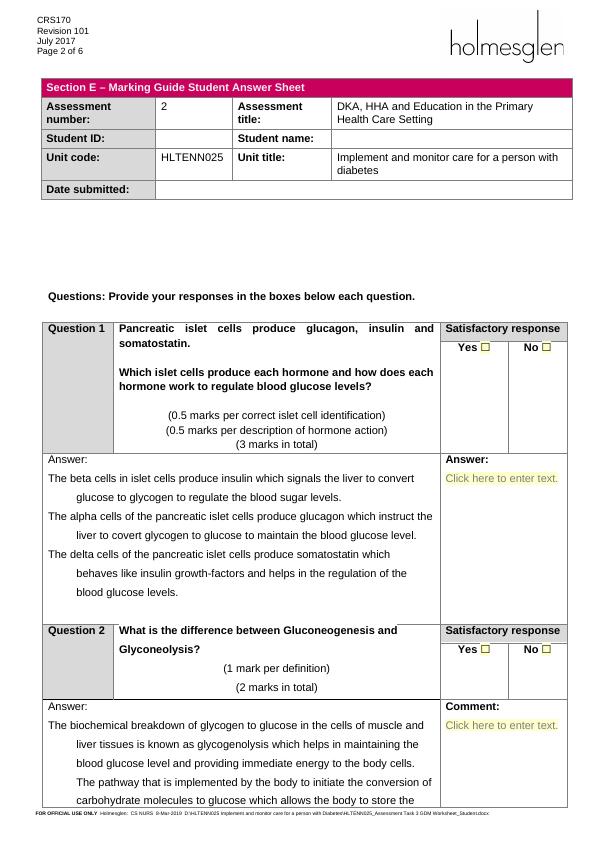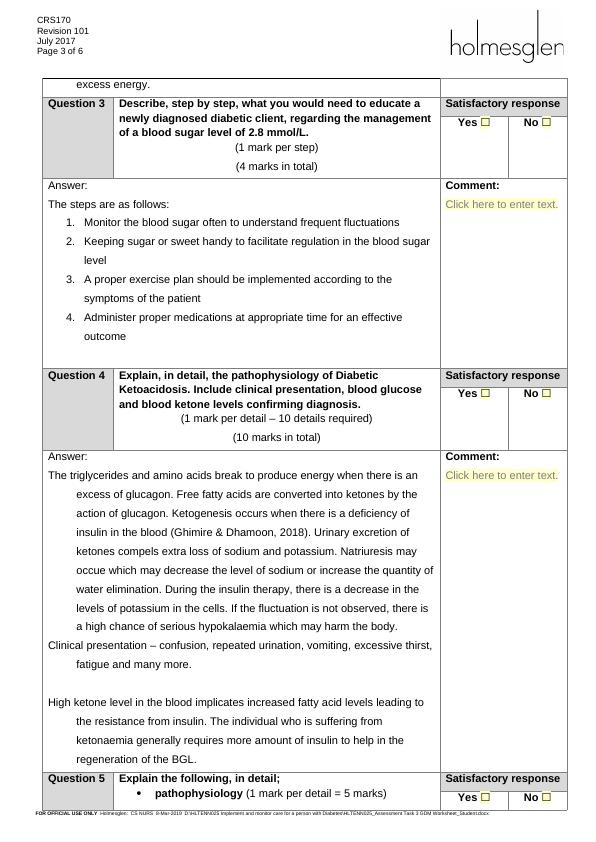DKA, HHA & Education in Primary Health Care Setting
Added on 2022-11-23
6 Pages2129 Words332 Views
CRS170
Revision 101
July 2017
Page 1 of 6
Assessment Task 2: DKA, HHA & Education in the Primary Health Care Setting
Student Version: Knowledge
Student information
Student name: Student
ID:
Section A – Program/Course details
Qualification code: HLT54115 Qualification title: Diploma of Nursing
Unit code: HLTENN025 Unit title: Implement and monitor
care for a person with
diabetes
Section B – Assessment task details
Assessment
number:
2 Semester/Year: Enter Semester/Year
Due date: Week 8 Date of submission:
Assessment task
results:
This assessment task will be marked as:
☒ Graded result: 40 marks. To be deemed satisfactory, a minimum score of 20/40
must be achieved.
☐ Other
Section D – Instructions to Students:
Task Instructions:
Students are to answer all questions using their own words.
Plagiarism will not be accepted.
Answers must be typed directly onto template provided.
Answers must be typed in Arial font size 12 and double spaced
Due date for this assessment tsk is week 8.
Students are allowed two attempts at this assessment task.
Any late submissions will be deemed as a second attempt.
FOR OFFICIAL USE ONLY Holmesglen: CS NURS 8-Mar-2019 D:\HLTENN025 Implement and monitor care for a person with Diabetes\HLTENN025_Assessment Task 3 GDM Worksheet_Student.docx
Section C – Conditions for Assessment
Conditions:
Students to enter their details on coversheet and answer questions on template provided.
Cover sheet and answers to be submitted together in word doc format. No jpegs, images,
screenshots or pdf formatted work will be accepted.
All pages must have the student’s name, ID number and signature on it, where stipulated
Due date for this assessment task is Week 8.
Any questions are to be addressed to the teacher.
This is an individual assessment task (No group answers will be allowed).
Answers to be typed using Arial font size 12 and double-spaced
Referencing in APA 6th Style (include Reference List and in-text referencing)
Plagiarism will not be accepted.
A minimum score of 20/40 to be deemed satisfactory for this assessment.
Students will be allowed two attempts to achieve a satisfactory result.
If a second attempt is required, this is to be completed one week after the first attempt to allow for
revision.
Students requiring a second attempt will be awarded a maximum score of 20/40 if they achieve a
satisfactory result.
Please let the teaching staff know if special consideration or adjustment will be required before the
assessment task begins. Approval must be confirmed prior to commencement.
Equipment/resources students must supply: Equipment/resources to be provided by the
RTO:
Pen/laptop, copy of Assessment Task Coversheet
and
worksheet
Assessment Task Cover sheet/worksheet to be
downloaded by the student, from Brightspace
Revision 101
July 2017
Page 1 of 6
Assessment Task 2: DKA, HHA & Education in the Primary Health Care Setting
Student Version: Knowledge
Student information
Student name: Student
ID:
Section A – Program/Course details
Qualification code: HLT54115 Qualification title: Diploma of Nursing
Unit code: HLTENN025 Unit title: Implement and monitor
care for a person with
diabetes
Section B – Assessment task details
Assessment
number:
2 Semester/Year: Enter Semester/Year
Due date: Week 8 Date of submission:
Assessment task
results:
This assessment task will be marked as:
☒ Graded result: 40 marks. To be deemed satisfactory, a minimum score of 20/40
must be achieved.
☐ Other
Section D – Instructions to Students:
Task Instructions:
Students are to answer all questions using their own words.
Plagiarism will not be accepted.
Answers must be typed directly onto template provided.
Answers must be typed in Arial font size 12 and double spaced
Due date for this assessment tsk is week 8.
Students are allowed two attempts at this assessment task.
Any late submissions will be deemed as a second attempt.
FOR OFFICIAL USE ONLY Holmesglen: CS NURS 8-Mar-2019 D:\HLTENN025 Implement and monitor care for a person with Diabetes\HLTENN025_Assessment Task 3 GDM Worksheet_Student.docx
Section C – Conditions for Assessment
Conditions:
Students to enter their details on coversheet and answer questions on template provided.
Cover sheet and answers to be submitted together in word doc format. No jpegs, images,
screenshots or pdf formatted work will be accepted.
All pages must have the student’s name, ID number and signature on it, where stipulated
Due date for this assessment task is Week 8.
Any questions are to be addressed to the teacher.
This is an individual assessment task (No group answers will be allowed).
Answers to be typed using Arial font size 12 and double-spaced
Referencing in APA 6th Style (include Reference List and in-text referencing)
Plagiarism will not be accepted.
A minimum score of 20/40 to be deemed satisfactory for this assessment.
Students will be allowed two attempts to achieve a satisfactory result.
If a second attempt is required, this is to be completed one week after the first attempt to allow for
revision.
Students requiring a second attempt will be awarded a maximum score of 20/40 if they achieve a
satisfactory result.
Please let the teaching staff know if special consideration or adjustment will be required before the
assessment task begins. Approval must be confirmed prior to commencement.
Equipment/resources students must supply: Equipment/resources to be provided by the
RTO:
Pen/laptop, copy of Assessment Task Coversheet
and
worksheet
Assessment Task Cover sheet/worksheet to be
downloaded by the student, from Brightspace

CRS170
Revision 101
July 2017
Page 2 of 6
Section E – Marking Guide Student Answer Sheet
Assessment
number:
2 Assessment
title:
DKA, HHA and Education in the Primary
Health Care Setting
Student ID: Student name:
Unit code: HLTENN025 Unit title: Implement and monitor care for a person with
diabetes
Date submitted:
Questions: Provide your responses in the boxes below each question.
Question 1 Pancreatic islet cells produce glucagon, insulin and
somatostatin.
Which islet cells produce each hormone and how does each
hormone work to regulate blood glucose levels?
(0.5 marks per correct islet cell identification)
(0.5 marks per description of hormone action)
(3 marks in total)
Satisfactory response
Yes ☐ No ☐
Answer:
The beta cells in islet cells produce insulin which signals the liver to convert
glucose to glycogen to regulate the blood sugar levels.
The alpha cells of the pancreatic islet cells produce glucagon which instruct the
liver to covert glycogen to glucose to maintain the blood glucose level.
The delta cells of the pancreatic islet cells produce somatostatin which
behaves like insulin growth-factors and helps in the regulation of the
blood glucose levels.
Answer:
Click here to enter text.
Question 2 What is the difference between Gluconeogenesis and
Glyconeolysis?
(1 mark per definition)
(2 marks in total)
Satisfactory response
Yes ☐ No ☐
Answer:
The biochemical breakdown of glycogen to glucose in the cells of muscle and
liver tissues is known as glycogenolysis which helps in maintaining the
blood glucose level and providing immediate energy to the body cells.
The pathway that is implemented by the body to initiate the conversion of
carbohydrate molecules to glucose which allows the body to store the
Comment:
Click here to enter text.
FOR OFFICIAL USE ONLY Holmesglen: CS NURS 8-Mar-2019 D:\HLTENN025 Implement and monitor care for a person with Diabetes\HLTENN025_Assessment Task 3 GDM Worksheet_Student.docx
Revision 101
July 2017
Page 2 of 6
Section E – Marking Guide Student Answer Sheet
Assessment
number:
2 Assessment
title:
DKA, HHA and Education in the Primary
Health Care Setting
Student ID: Student name:
Unit code: HLTENN025 Unit title: Implement and monitor care for a person with
diabetes
Date submitted:
Questions: Provide your responses in the boxes below each question.
Question 1 Pancreatic islet cells produce glucagon, insulin and
somatostatin.
Which islet cells produce each hormone and how does each
hormone work to regulate blood glucose levels?
(0.5 marks per correct islet cell identification)
(0.5 marks per description of hormone action)
(3 marks in total)
Satisfactory response
Yes ☐ No ☐
Answer:
The beta cells in islet cells produce insulin which signals the liver to convert
glucose to glycogen to regulate the blood sugar levels.
The alpha cells of the pancreatic islet cells produce glucagon which instruct the
liver to covert glycogen to glucose to maintain the blood glucose level.
The delta cells of the pancreatic islet cells produce somatostatin which
behaves like insulin growth-factors and helps in the regulation of the
blood glucose levels.
Answer:
Click here to enter text.
Question 2 What is the difference between Gluconeogenesis and
Glyconeolysis?
(1 mark per definition)
(2 marks in total)
Satisfactory response
Yes ☐ No ☐
Answer:
The biochemical breakdown of glycogen to glucose in the cells of muscle and
liver tissues is known as glycogenolysis which helps in maintaining the
blood glucose level and providing immediate energy to the body cells.
The pathway that is implemented by the body to initiate the conversion of
carbohydrate molecules to glucose which allows the body to store the
Comment:
Click here to enter text.
FOR OFFICIAL USE ONLY Holmesglen: CS NURS 8-Mar-2019 D:\HLTENN025 Implement and monitor care for a person with Diabetes\HLTENN025_Assessment Task 3 GDM Worksheet_Student.docx

CRS170
Revision 101
July 2017
Page 3 of 6
excess energy.
Question 3 Describe, step by step, what you would need to educate a
newly diagnosed diabetic client, regarding the management
of a blood sugar level of 2.8 mmol/L.
(1 mark per step)
(4 marks in total)
Satisfactory response
Yes ☐ No ☐
Answer:
The steps are as follows:
1. Monitor the blood sugar often to understand frequent fluctuations
2. Keeping sugar or sweet handy to facilitate regulation in the blood sugar
level
3. A proper exercise plan should be implemented according to the
symptoms of the patient
4. Administer proper medications at appropriate time for an effective
outcome
Comment:
Click here to enter text.
Question 4 Explain, in detail, the pathophysiology of Diabetic
Ketoacidosis. Include clinical presentation, blood glucose
and blood ketone levels confirming diagnosis.
(1 mark per detail – 10 details required)
(10 marks in total)
Satisfactory response
Yes ☐ No ☐
Answer:
The triglycerides and amino acids break to produce energy when there is an
excess of glucagon. Free fatty acids are converted into ketones by the
action of glucagon. Ketogenesis occurs when there is a deficiency of
insulin in the blood (Ghimire & Dhamoon, 2018). Urinary excretion of
ketones compels extra loss of sodium and potassium. Natriuresis may
occue which may decrease the level of sodium or increase the quantity of
water elimination. During the insulin therapy, there is a decrease in the
levels of potassium in the cells. If the fluctuation is not observed, there is
a high chance of serious hypokalaemia which may harm the body.
Clinical presentation – confusion, repeated urination, vomiting, excessive thirst,
fatigue and many more.
High ketone level in the blood implicates increased fatty acid levels leading to
the resistance from insulin. The individual who is suffering from
ketonaemia generally requires more amount of insulin to help in the
regeneration of the BGL.
Comment:
Click here to enter text.
Question 5 Explain the following, in detail;
pathophysiology (1 mark per detail = 5 marks)
Satisfactory response
Yes ☐ No ☐
FOR OFFICIAL USE ONLY Holmesglen: CS NURS 8-Mar-2019 D:\HLTENN025 Implement and monitor care for a person with Diabetes\HLTENN025_Assessment Task 3 GDM Worksheet_Student.docx
Revision 101
July 2017
Page 3 of 6
excess energy.
Question 3 Describe, step by step, what you would need to educate a
newly diagnosed diabetic client, regarding the management
of a blood sugar level of 2.8 mmol/L.
(1 mark per step)
(4 marks in total)
Satisfactory response
Yes ☐ No ☐
Answer:
The steps are as follows:
1. Monitor the blood sugar often to understand frequent fluctuations
2. Keeping sugar or sweet handy to facilitate regulation in the blood sugar
level
3. A proper exercise plan should be implemented according to the
symptoms of the patient
4. Administer proper medications at appropriate time for an effective
outcome
Comment:
Click here to enter text.
Question 4 Explain, in detail, the pathophysiology of Diabetic
Ketoacidosis. Include clinical presentation, blood glucose
and blood ketone levels confirming diagnosis.
(1 mark per detail – 10 details required)
(10 marks in total)
Satisfactory response
Yes ☐ No ☐
Answer:
The triglycerides and amino acids break to produce energy when there is an
excess of glucagon. Free fatty acids are converted into ketones by the
action of glucagon. Ketogenesis occurs when there is a deficiency of
insulin in the blood (Ghimire & Dhamoon, 2018). Urinary excretion of
ketones compels extra loss of sodium and potassium. Natriuresis may
occue which may decrease the level of sodium or increase the quantity of
water elimination. During the insulin therapy, there is a decrease in the
levels of potassium in the cells. If the fluctuation is not observed, there is
a high chance of serious hypokalaemia which may harm the body.
Clinical presentation – confusion, repeated urination, vomiting, excessive thirst,
fatigue and many more.
High ketone level in the blood implicates increased fatty acid levels leading to
the resistance from insulin. The individual who is suffering from
ketonaemia generally requires more amount of insulin to help in the
regeneration of the BGL.
Comment:
Click here to enter text.
Question 5 Explain the following, in detail;
pathophysiology (1 mark per detail = 5 marks)
Satisfactory response
Yes ☐ No ☐
FOR OFFICIAL USE ONLY Holmesglen: CS NURS 8-Mar-2019 D:\HLTENN025 Implement and monitor care for a person with Diabetes\HLTENN025_Assessment Task 3 GDM Worksheet_Student.docx

End of preview
Want to access all the pages? Upload your documents or become a member.
Related Documents
Assignment on Diploma of Nursing Unit Codelg...
|7
|2734
|173
DKA, HHA & Education in the Primary Health Care Settinglg...
|8
|2923
|168
Conditions for Assessmentlg...
|7
|2977
|265
Assessment Task 1: Gestational Diabetes Mellitus Tutorial Worksheet Student Version: Gestational Diabetes Mellituslg...
|9
|2631
|362
CRS170 Revision 101 July 2017 Page 1 of 11.lg...
|11
|3913
|72
Performing Nursing Interventions for a Person with Complex Needslg...
|22
|4677
|58